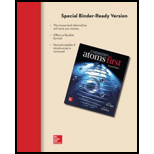
Concept explainers
(a)
Interpretation:
The molecular models commonly used to be illustrated.
Concept Introduction:
Covalent bonding: A covalent bond is formed by sharing of electrons (equally or partially polarized) between the two non-metals.
Octet rule: By obtaining eight electrons around the valence shell of an element, then compound satisfied the octet rule and thus, achieved the electron configuration of noble gas.
(b)
Interpretation:
The molecular models commonly used to be illustrated.
Concept Introduction:
Covalent bonding: A covalent bond is formed by sharing of electrons (equally or partially polarized) between the two non-metals.
Octet rule: By obtaining eight electrons around the valence shell of an element, then compound satisfied the octet rule and thus, achieved the electron configuration of noble gas.
Want to see the full answer?
Check out a sample textbook solution
Chapter 5 Solutions
Chemistry: Atoms First (Looseleaf)-Package
- Contrast the two general types of chemical compounds in terms of their general physical properties.arrow_forwardFill in the blankarrow_forwardComplete the table, and then analyze the data to determine if Compounds Iand II are the same compound. If the compounds are different, use the law ofmultiple proportions to show the relationship between thearrow_forward
- ľ esc ! 1 What are the molecular and empirical chemical formulas of a compound made up of these molecules? :O: H H :O: A Q HO—C—C—C—C—Ö-H Z molecular formula: empirical formula: Exanation 2 W S X 88 command Check 3 E U 0 D C $ 4 The lines stand for chemical bonds between the atoms. You can ignore the dots -- they represent" you'll learn about them later. R F X Costa % 5 V T G 6 MacBook Pro B Y I H & 7 U N 2022 McGraw Hill LLC. All Rights Reserved. Terms of Use | Privacy * 00 8 J You 3 ( K O commandarrow_forwardExplain the relationship between molecules and compounds.arrow_forwardIdentify whether carbon dioxide (CO2) and nitrogen gas (N2)are considered molecules, compounds, or both.arrow_forward
- Which of the following statements about compounds and molecules are true? not all compounds are molecules all molecules are compounds not all molecules are compounds all compounds are moleculesarrow_forwardWhy do scientists use different types of models to represent compounds?arrow_forwardMolecules and compounds are made up of many atoms, however, not all molecules are compounds. Which molecules are not considered to be compounds? What evidence do you have to make that conclusion?arrow_forward
 Chemistry: Principles and PracticeChemistryISBN:9780534420123Author:Daniel L. Reger, Scott R. Goode, David W. Ball, Edward MercerPublisher:Cengage Learning
Chemistry: Principles and PracticeChemistryISBN:9780534420123Author:Daniel L. Reger, Scott R. Goode, David W. Ball, Edward MercerPublisher:Cengage Learning Chemistry: The Molecular ScienceChemistryISBN:9781285199047Author:John W. Moore, Conrad L. StanitskiPublisher:Cengage Learning
Chemistry: The Molecular ScienceChemistryISBN:9781285199047Author:John W. Moore, Conrad L. StanitskiPublisher:Cengage Learning Introductory Chemistry: An Active Learning Approa...ChemistryISBN:9781305079250Author:Mark S. Cracolice, Ed PetersPublisher:Cengage Learning
Introductory Chemistry: An Active Learning Approa...ChemistryISBN:9781305079250Author:Mark S. Cracolice, Ed PetersPublisher:Cengage Learning General, Organic, and Biological ChemistryChemistryISBN:9781285853918Author:H. Stephen StokerPublisher:Cengage Learning
General, Organic, and Biological ChemistryChemistryISBN:9781285853918Author:H. Stephen StokerPublisher:Cengage Learning General Chemistry - Standalone book (MindTap Cour...ChemistryISBN:9781305580343Author:Steven D. Gammon, Ebbing, Darrell Ebbing, Steven D., Darrell; Gammon, Darrell Ebbing; Steven D. Gammon, Darrell D.; Gammon, Ebbing; Steven D. Gammon; DarrellPublisher:Cengage Learning
General Chemistry - Standalone book (MindTap Cour...ChemistryISBN:9781305580343Author:Steven D. Gammon, Ebbing, Darrell Ebbing, Steven D., Darrell; Gammon, Darrell Ebbing; Steven D. Gammon, Darrell D.; Gammon, Ebbing; Steven D. Gammon; DarrellPublisher:Cengage Learning Introductory Chemistry: A FoundationChemistryISBN:9781337399425Author:Steven S. Zumdahl, Donald J. DeCostePublisher:Cengage Learning
Introductory Chemistry: A FoundationChemistryISBN:9781337399425Author:Steven S. Zumdahl, Donald J. DeCostePublisher:Cengage Learning





